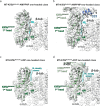Microtubule association induces a Mg-free apo-like ADP pre-release conformation in kinesin-1 that is unaffected by its autoinhibitory tail
- PMID: 40617823
- PMCID: PMC12228791
- DOI: 10.1038/s41467-025-61498-3
Microtubule association induces a Mg-free apo-like ADP pre-release conformation in kinesin-1 that is unaffected by its autoinhibitory tail
Abstract
Kinesin-1 is a processive dimeric ATP-driven motor that transports vital intracellular cargos along microtubules (MTs). If not engaged in active transport, kinesin-1 limits futile ATP hydrolysis by adopting a compact autoinhibited conformation that involves an interaction between its C-terminal tail and the N-terminal motor domains. Here, using a chimeric kinesin-1 that fuses the N-terminal motor region to the tail and a tail variant unable to interact with the motors, we employ cryo-EM to investigate elements of the MT-associated mechanochemical cycle. We describe a missing structure for the proposed two-step allosteric mechanism of ADP release, the ATPase rate limiting step. It shows that MT association remodels the hydrogen bond network at the nucleotide binding site triggering removal of the Mg2+ ion from the Mg2+-ADP complex. This results in a strong MT-binding apo-like state before ADP dissociation, which molecular dynamics simulations indicate is mediated by loop 9 dynamics. We further demonstrate that tail association does not directly affect this mechanism, nor the adoption of the ATP hydrolysis-competent conformation, nor neck linker docking/undocking, even when zippering the two motor domains. We propose a revised mechanism for tail-dependent kinesin-1 autoinhibition and suggest a possible explanation for its characteristic pausing behavior on MTs.
© 2025. The Author(s).
Conflict of interest statement
Competing interests: The authors declare no competing interests.
Figures







Similar articles
-
The kinesin-5 tail domain directly modulates the mechanochemical cycle of the motor domain for anti-parallel microtubule sliding.Elife. 2020 Jan 20;9:e51131. doi: 10.7554/eLife.51131. Elife. 2020. PMID: 31958056 Free PMC article.
-
Tension-induced suppression of allosteric conformational changes coordinates kinesin-1 stepping.J Cell Biol. 2025 Jul 7;224(7):e202501253. doi: 10.1083/jcb.202501253. Epub 2025 Apr 29. J Cell Biol. 2025. PMID: 40298806
-
Biased movement of monomeric kinesin-3 KLP-6 explained by a symmetric Brownian ratchet model.Biophys J. 2025 Jan 7;124(1):205-214. doi: 10.1016/j.bpj.2024.11.3312. Epub 2024 Nov 26. Biophys J. 2025. PMID: 39604259
-
Signs and symptoms to determine if a patient presenting in primary care or hospital outpatient settings has COVID-19.Cochrane Database Syst Rev. 2022 May 20;5(5):CD013665. doi: 10.1002/14651858.CD013665.pub3. Cochrane Database Syst Rev. 2022. PMID: 35593186 Free PMC article.
-
The Black Book of Psychotropic Dosing and Monitoring.Psychopharmacol Bull. 2024 Jul 8;54(3):8-59. Psychopharmacol Bull. 2024. PMID: 38993656 Free PMC article. Review.
Cited by
-
Conserved function of the HAUS6 calponin homology domain in anchoring augmin for microtubule branching.Nat Commun. 2025 Aug 22;16(1):7845. doi: 10.1038/s41467-025-63165-z. Nat Commun. 2025. PMID: 40846850 Free PMC article.
References
-
- Hirokawa, N., Noda, Y., Tanaka, Y. & Niwa, S. Kinesin superfamily motor proteins and intracellular transport. Nat. Rev. Mol. Cell Biol.10, 682–696 (2009). - PubMed
-
- Hollenbeck, P. J. & Swanson, J. A. Radial extension of macrophage tubular lysosomes supported by kinesin. Nature346, 864–866 (1990). - PubMed
MeSH terms
Substances
Grants and funding
- 206175/Z/17/Z/Wellcome Trust (Wellcome)
- BB/V006568/1/RCUK | Biotechnology and Biological Sciences Research Council (BBSRC)
- WT_/Wellcome Trust/United Kingdom
- P2022LSH5A/Ministero dell'Istruzione, dell'Università e della Ricerca (Ministry of Education, University and Research)
- 2022ERB7SL/Ministero dell'Istruzione, dell'Università e della Ricerca (Ministry of Education, University and Research)
LinkOut - more resources
Full Text Sources

